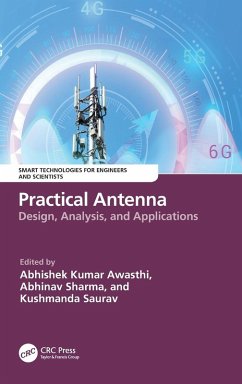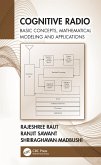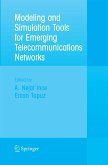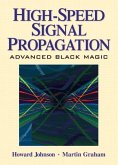Practical Antenna
Design, Analysis, and Applications
Herausgeber: Awasthi, Abhishek Kumar; Saurav, Kushmanda; Sharma, Abhinav
Practical Antenna
Design, Analysis, and Applications
Herausgeber: Awasthi, Abhishek Kumar; Saurav, Kushmanda; Sharma, Abhinav
- Gebundenes Buch
- Merkliste
- Auf die Merkliste
- Bewerten Bewerten
- Teilen
- Produkt teilen
- Produkterinnerung
- Produkterinnerung
The text provides information on antenna design for next generation communication systems and IoT applications, followed by the integration of the antennas in the wireless system. It also covers multi-input and multi-output antennas, metasurface antennas, reconfigurable antennas, fractal antennas and design of beamforming networks.
Andere Kunden interessierten sich auch für
![Stacked Antennas Stacked Antennas]() Ankita MalhotraStacked Antennas174,99 €
Ankita MalhotraStacked Antennas174,99 €![Applications of Computational Intelligence Techniques in Communications Applications of Computational Intelligence Techniques in Communications]() Applications of Computational Intelligence Techniques in Communications127,99 €
Applications of Computational Intelligence Techniques in Communications127,99 €![6g Communication Network 6g Communication Network]() 6g Communication Network231,99 €
6g Communication Network231,99 €![Cognitive Radio Cognitive Radio]() Rajeshree RautCognitive Radio153,99 €
Rajeshree RautCognitive Radio153,99 €![Secure Communication in Internet of Things Secure Communication in Internet of Things]() Secure Communication in Internet of Things174,99 €
Secure Communication in Internet of Things174,99 €![Modeling and Simulation Tools for Emerging Telecommunication Networks Modeling and Simulation Tools for Emerging Telecommunication Networks]() Nejat Ince / Ercan Topuz (eds.)Modeling and Simulation Tools for Emerging Telecommunication Networks240,99 €
Nejat Ince / Ercan Topuz (eds.)Modeling and Simulation Tools for Emerging Telecommunication Networks240,99 €![High Speed Signal Propagation High Speed Signal Propagation]() Howard JohnsonHigh Speed Signal Propagation131,99 €
Howard JohnsonHigh Speed Signal Propagation131,99 €-
-
-
The text provides information on antenna design for next generation communication systems and IoT applications, followed by the integration of the antennas in the wireless system. It also covers multi-input and multi-output antennas, metasurface antennas, reconfigurable antennas, fractal antennas and design of beamforming networks.
Hinweis: Dieser Artikel kann nur an eine deutsche Lieferadresse ausgeliefert werden.
Hinweis: Dieser Artikel kann nur an eine deutsche Lieferadresse ausgeliefert werden.
Produktdetails
- Produktdetails
- Verlag: CRC Press
- Seitenzahl: 225
- Erscheinungstermin: 3. Dezember 2024
- Englisch
- Abmessung: 234mm x 156mm x 14mm
- Gewicht: 517g
- ISBN-13: 9781032743660
- ISBN-10: 1032743662
- Artikelnr.: 70898866
- Herstellerkennzeichnung
- Libri GmbH
- Europaallee 1
- 36244 Bad Hersfeld
- gpsr@libri.de
- Verlag: CRC Press
- Seitenzahl: 225
- Erscheinungstermin: 3. Dezember 2024
- Englisch
- Abmessung: 234mm x 156mm x 14mm
- Gewicht: 517g
- ISBN-13: 9781032743660
- ISBN-10: 1032743662
- Artikelnr.: 70898866
- Herstellerkennzeichnung
- Libri GmbH
- Europaallee 1
- 36244 Bad Hersfeld
- gpsr@libri.de
Abhishek Kumar Awasthi completed his B. Tech. in Electronics and Communication Engineering from Ajay Kumar Garg Engineering College Ghaziabad (UPTU Lucknow) in the year 2008. He did his M. Tech. in Digital Communication from Ambedkar Institute of Technology Delhi (GGSIP University Delhi) in 2011 and doctoral degree from the Department of Electrical Engineering (RF and Microwave) of Indian Institute of Technology Kanpur in 2018. Currently he is working as a Deputy Manager RF, Paras Antidrone Technologies Private Limited, Mumbai, India. Prior to that he has worked at Remote Sensing Center at The University of Alabama, Tuscaloosa, AL USA as an Associate Research Engineer. His major research interests include design, optimize, fabricate, and develop various active and passive microwave circuits for the radars. Particularly, he is working on the radars with application in ice sounding and soil moisture measurement. He has also actively worked on the assembly and field test of the radar for soil moisture and snow measurements. Apart from radar design, he has worked on the antenna array design for various applications. He has mainly worked on design of the antenna arrays which includes the study of inter-element coupling and its effects on the performance of the antenna arrays, design of compact and ultra-wide band antenna arrays, shared aperture antenna arrays, antenna arrays for airborne applications. Abhinav Sharma received his B. Tech. from H. N. B. Garhwal University, Srinagar, India, in 2009 and the M. Tech. and Ph. D. from Govind Ballabh Pant University of Agriculture and Technology, Pantnagar, India, in 2011 and 2016. He is working as an Associate Professor in the Department of Electrical and Electronics Engineering in University of Petroleum and Energy Studies, Dehradun. He has taught subjects such as data communication networks, microprocessor and embedded system, artificial intelligence and machine learning, communication systems. He has publications in many national and international journals and conferences. His field of interest includes adaptive array signal processing, artificial intelligence, and machine learning, optimization techniques and smart antennas. Kushmanda Saurav received the B.E. degree in electronics and telecommunication from Bengal Engineering and Science University, Shibpur, India, in 2009, the M. Tech. degree in electronics and communication engineering from IIT Roorkee, India, in 2011, and the Ph.D. degree in electrical engineering from IIT Kanpur, India, in 2017. He worked as a Postdoctoral Fellow with the Royal Military College Canada. He is currently an Assistant Professor with the Department of Electrical Engineering, IIT Jammu, India. His research interests include microwave and millimeter wave antennas and frequency selective surfaces. He has published more than 75 research papers in esteemed journals and conferences. He has served as reviewers in IEEE, IET and Wiley Journals. He is actively involved in the professional activities of the IEEE. He is a senior member of IEEE and currently the faculty advisor of IEEE MTTS and APS Student Branch Chapters of IIT Jammu. He has rich experience of supervising M. Tech. and PhD students and undertaking sponsored projects.
1. Dual-band Circularly Polarized MIMO Antenna Deploying a Dual-band
Transmission Type Linear to Circular Polarization Converter. 2. Design and
Optimization of Metasurface Antennas in Wireless Communication. 3. Wideband
and Multi-band Circularly Polarized Planar Slot Antennas. 4. Multi Input
Multi Output Antennas. 5. Exploring the Dynamics of Microstrip Monopole
Antenna and Radiation Mechanism of Dipole Antennas. 6. 28/38GHz Millimetre
Wave MIMO Antenna for 5G Wireless Communication Systems. 7. Pattern
Synthesis of a Linear Antenna Array using Sooty Tern Optimization
Algorithm. 8. 1-D and 2-D Beam-Switching Transmit Array Antennas for
Millimetre Wave Base Stations and Vehicular Networks. 9. An Array of
Highly-directive Printed Fractal Radiators for D2H Applications. 10. Design
of Microstrip Patch Array Antennas for IoT Applications.
Transmission Type Linear to Circular Polarization Converter. 2. Design and
Optimization of Metasurface Antennas in Wireless Communication. 3. Wideband
and Multi-band Circularly Polarized Planar Slot Antennas. 4. Multi Input
Multi Output Antennas. 5. Exploring the Dynamics of Microstrip Monopole
Antenna and Radiation Mechanism of Dipole Antennas. 6. 28/38GHz Millimetre
Wave MIMO Antenna for 5G Wireless Communication Systems. 7. Pattern
Synthesis of a Linear Antenna Array using Sooty Tern Optimization
Algorithm. 8. 1-D and 2-D Beam-Switching Transmit Array Antennas for
Millimetre Wave Base Stations and Vehicular Networks. 9. An Array of
Highly-directive Printed Fractal Radiators for D2H Applications. 10. Design
of Microstrip Patch Array Antennas for IoT Applications.
1. Dual-band Circularly Polarized MIMO Antenna Deploying a Dual-band
Transmission Type Linear to Circular Polarization Converter. 2. Design and
Optimization of Metasurface Antennas in Wireless Communication. 3. Wideband
and Multi-band Circularly Polarized Planar Slot Antennas. 4. Multi Input
Multi Output Antennas. 5. Exploring the Dynamics of Microstrip Monopole
Antenna and Radiation Mechanism of Dipole Antennas. 6. 28/38GHz Millimetre
Wave MIMO Antenna for 5G Wireless Communication Systems. 7. Pattern
Synthesis of a Linear Antenna Array using Sooty Tern Optimization
Algorithm. 8. 1-D and 2-D Beam-Switching Transmit Array Antennas for
Millimetre Wave Base Stations and Vehicular Networks. 9. An Array of
Highly-directive Printed Fractal Radiators for D2H Applications. 10. Design
of Microstrip Patch Array Antennas for IoT Applications.
Transmission Type Linear to Circular Polarization Converter. 2. Design and
Optimization of Metasurface Antennas in Wireless Communication. 3. Wideband
and Multi-band Circularly Polarized Planar Slot Antennas. 4. Multi Input
Multi Output Antennas. 5. Exploring the Dynamics of Microstrip Monopole
Antenna and Radiation Mechanism of Dipole Antennas. 6. 28/38GHz Millimetre
Wave MIMO Antenna for 5G Wireless Communication Systems. 7. Pattern
Synthesis of a Linear Antenna Array using Sooty Tern Optimization
Algorithm. 8. 1-D and 2-D Beam-Switching Transmit Array Antennas for
Millimetre Wave Base Stations and Vehicular Networks. 9. An Array of
Highly-directive Printed Fractal Radiators for D2H Applications. 10. Design
of Microstrip Patch Array Antennas for IoT Applications.








